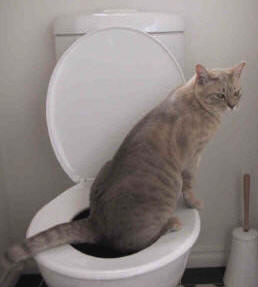Don't Flush Cat Poop Down Your Toilet - Maintain Your Home's Pipe System
Don't Flush Cat Poop Down Your Toilet - Maintain Your Home's Pipe System
Blog Article
We have unearthed this great article involving How to Dispose of Cat Poop and Litter Without Plastic Bags directly below on the web and think it made perfect sense to talk about it with you in this article.

Intro
As cat proprietors, it's vital to bear in mind how we deal with our feline buddies' waste. While it might seem practical to flush pet cat poop down the toilet, this practice can have damaging consequences for both the environment and human health.
Alternatives to Flushing
Luckily, there are more secure and more responsible methods to throw away pet cat poop. Take into consideration the following alternatives:
1. Scoop and Dispose in Trash
One of the most common method of getting rid of feline poop is to scoop it right into an eco-friendly bag and toss it in the garbage. Make sure to make use of a specialized clutter inside story and dispose of the waste quickly.
2. Use Biodegradable Litter
Choose naturally degradable feline trash made from materials such as corn or wheat. These litters are environmentally friendly and can be safely gotten rid of in the trash.
3. Bury in the Yard
If you have a backyard, take into consideration hiding feline waste in an assigned area away from vegetable yards and water resources. Make sure to dig deep sufficient to stop contamination of groundwater.
4. Mount a Pet Waste Disposal System
Buy a family pet waste disposal system specifically designed for cat waste. These systems make use of enzymes to break down the waste, minimizing odor and environmental influence.
Health Risks
Along with ecological issues, flushing pet cat waste can additionally present health threats to people. Feline feces may have Toxoplasma gondii, a parasite that can create toxoplasmosis-- a possibly serious disease, particularly for expectant ladies and individuals with damaged body immune systems.
Environmental Impact
Flushing pet cat poop introduces harmful virus and bloodsuckers into the water supply, posturing a significant threat to water environments. These contaminants can adversely affect marine life and concession water high quality.
Conclusion
Accountable pet possession prolongs past offering food and sanctuary-- it likewise involves correct waste administration. By avoiding flushing pet cat poop down the bathroom and choosing alternative disposal approaches, we can lessen our environmental impact and protect human health and wellness.
Why Can’t I Flush Cat Poop?
It Spreads a Parasite
Cats are frequently infected with a parasite called toxoplasma gondii. The parasite causes an infection called toxoplasmosis. It is usually harmless to cats. The parasite only uses cat poop as a host for its eggs. Otherwise, the cat’s immune system usually keeps the infection at low enough levels to maintain its own health. But it does not stop the develop of eggs. These eggs are tiny and surprisingly tough. They may survive for a year before they begin to grow. But that’s the problem.
Our wastewater system is not designed to deal with toxoplasmosis eggs. Instead, most eggs will flush from your toilet into sewers and wastewater management plants. After the sewage is treated for many other harmful things in it, it is typically released into local rivers, lakes, or oceans. Here, the toxoplasmosis eggs can find new hosts, including starfish, crabs, otters, and many other wildlife. For many, this is a significant risk to their health. Toxoplasmosis can also end up infecting water sources that are important for agriculture, which means our deer, pigs, and sheep can get infected too.
Is There Risk to Humans?
There can be a risk to human life from flushing cat poop down the toilet. If you do so, the parasites from your cat’s poop can end up in shellfish, game animals, or livestock. If this meat is then served raw or undercooked, the people who eat it can get sick.
In fact, according to the CDC, 40 million people in the United States are infected with toxoplasma gondii. They get it from exposure to infected seafood, or from some kind of cat poop contamination, like drinking from a stream that is contaminated or touching anything that has come into contact with cat poop. That includes just cleaning a cat litter box.
Most people who get infected with these parasites will not develop any symptoms. However, for pregnant women or for those with compromised immune systems, the parasite can cause severe health problems.
How to Handle Cat Poop
The best way to handle cat poop is actually to clean the box more often. The eggs that the parasite sheds will not become active until one to five days after the cat poops. That means that if you clean daily, you’re much less likely to come into direct contact with infectious eggs.
That said, always dispose of cat poop in the garbage and not down the toilet. Wash your hands before and after you clean the litter box, and bring the bag of poop right outside to your garbage bins.
https://trenchlesssolutionsusa.com/why-cant-i-flush-cat-poop/

Do you appreciate reading about How to Dispose of Cat Poop and Litter Without Plastic Bags? Give feedback down the page. We'd be glad to find out your suggestions about this posting. In hopes that you visit us again before long. Are you aware of anybody else who is truly interested in the subject? Be sure share it. We value reading our article about Don’t flush cat feces down the toilet.
Call Today Report this page